Collection: Immaculate Conception
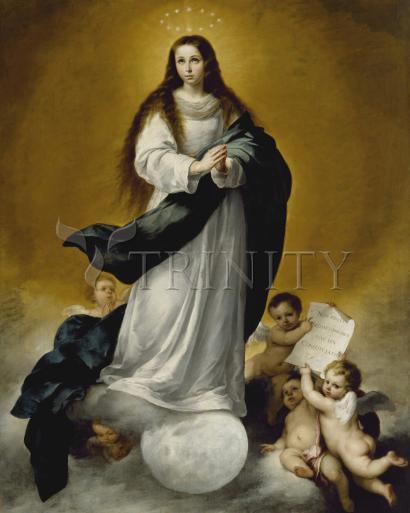
-
Sale
Wood Plaque Premium
Regular price From $99.95 USDRegular priceUnit price per$111.06 USDSale price From $99.95 USDSale -
Sale
Wood Plaque
Regular price From $34.95 USDRegular priceUnit price per$38.83 USDSale price From $34.95 USDSale -
Sale
Wall Frame Espresso
Regular price From $109.95 USDRegular priceUnit price per$122.17 USDSale price From $109.95 USDSale -
Sale
Wall Frame Gold
Regular price From $109.95 USDRegular priceUnit price per$122.17 USDSale price From $109.95 USDSale -
Sale
Wall Frame Black
Regular price From $109.95 USDRegular priceUnit price per$122.17 USDSale price From $109.95 USDSale -
Sale
Canvas Print
Regular price From $84.95 USDRegular priceUnit price per$94.39 USDSale price From $84.95 USDSale -
Sale
Metal Print
Regular price From $94.95 USDRegular priceUnit price per$105.50 USDSale price From $94.95 USDSale -
Sale
Acrylic Print
Regular price From $94.95 USDRegular priceUnit price per$105.50 USDSale price From $94.95 USDSale -
Sale
Giclée Print
Regular price From $19.95 USDRegular priceUnit price per$22.17 USDSale price From $19.95 USDSale -
Custom Text Note Card
Regular price From $300.00 USDRegular priceUnit price per$333.33 USDSale price From $300.00 USDSale
ARTIST: Museum Religious Art Classics
ARTWORK NARRATIVE:
Artist: Bartolomé Estebán Murillo – c. 1660
According to the Catholic doctrine of the Immaculate Conception, the Virgin was already free from the original sin that applied to all the descendants of Adam and Eve at the moment she was conceived by her parents. This became official dogma in 1854 but was widely accepted long before, especially in 17th-century Counter Reformation Spain.
The image of a virgin whose triumph over sin is acknowledged by the cosmos in the form of a crown of stars, an aura of golden light from the sun, and the moon for a footrest is from the Book of Revelation. At Mary's feet, cherubim hold a proclamation of the uniqueness of her freedom from sin taken from the story of the Old Testament heroine Esther: "for this law does not apply to you but for all others."
Many artists in Murillo's native Seville specialized in the Immaculate Conception, but none equaled him in giving pictorial form to the Virgin's purity through the delicate use of color and light. The difference in style between the polished brushstrokes defining the Virgin's face and the more fluid rendering of the lively cherubim suggests that two assistants collaborated in painting this altarpiece.
Feast day is December 8.
- Art Collection:
-
Mary Images
Additional Items Our Customers Like
-
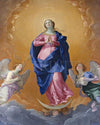
Immaculate Conception (by Museum Religious Art Classics)
-
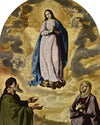
Immaculate Conception with Sts. Joachim and Anne (by Museum Religious Art Classics)
-

India Joseph (by Br. Mickey McGrath, OSFS)
-
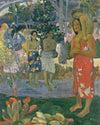
Ia Orana Maria 'Hail Mary' in Tahitian (by Museum Religious Art Classics)
-
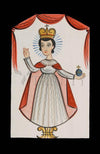
Infant of Prague (by Br. Arturo Olivas, OFS)
-

Infant of Prague (by Dan Paulos)


















